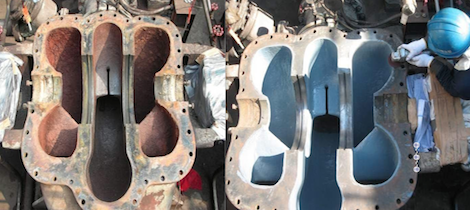Over the next several months I hope to address the topic of coatings and linings for pumps and pump systems within the process industries. Way back in the 1948 Alexey J. Stepanoff wrote in Centrifugal and Axial Flow Pumps: Theory, Design, and Application that, “While failure of seals or bearings may be immediately apparent, the deterioration in pump hydraulics is unlikely to be obvious. This can have many sources, chemical erosion, physical abrasion, deposition. The use of glass or resin coatings can help to increase and maintain a good hydraulic efficiency over a long period of time, and for larger pumps many users specify these coatings as standard. Improvements in efficiency of 2-3% are typical. This is a practice that should be encouraged.” Since that time arguments have gone back and forth on the pros and cons, risk and rewards of to coat or not to coat. To paraphrase William Shakespeare, “Whether ’tis nobler in the process industry to suffer premature pump failure, system disruption and increased maintenance costs or to take action against known factors and, by opposing them, to face unplanned shut down no more”.
Pump suppliers have often taken a skeptical view of the value of a coating while pump owners have often relied on coatings to prolong service life in process conditions such as chemically reactive solutions and/or abrasive slurries. Can a coating negatively impact pump performance? Can a coating promote extended service life? The reality, as one would expect, lies in the middle ground and, it is this author’s position that, when properly evaluated, selected and installed a coating can provide valuable benefits such as extended MTBR, reduced operational expenses, and lower overall life cycle costs. What then should a “user” consider when evaluating the pros and cons of a coating option for a pump? First a thorough understanding of the pump manufacturer’s pump curves, pump process conditions including but not limited to; flow/velocity, process media (chemicals present in their concentrations) , total suspended solids (density, % presence, particle size range and shape) and operational temperature ranges (high and low).
A coating should be able to effectively protect a pump element (volute, impellor, back plate, suction spool, discharge, etc) for a period of time understood and agreed upon by the user. The coating manufacturer/supplier should be able to recommend a product based on the operating parameters defined by the user. The user needs to understand that any coating is a surface treatment only, and that once a coating is installed it starts a progressive degradation process. At first this process is imperceptible but over time the coating breaks down and two things start to happen. First the coating enters the process stream, either in a solution or in a suspended solid state, and the process owner needs to understand how that can impact his process. In a wastewater pump a coating breaking down and entering the process flow may not be a significant issue. This may not be the case in a pharmaceutical or food process. The second thing that starts to happen is that the pump metallurgy is now exposed to the process conditions and accelerated attack can occur at these points leading to premature system upset. Understanding the two stages of breakdown and what one can do in the evaluation, selection and installation stages of pump coatings systems is where the time needs to be spent.
In the next installment I will address some of the various coatings available, and how each can evaluated to offer value to the operational reliability and efficiency of the pump. I welcome any feedback and look forward to contributing in this forum.
To contact me, please email me at Steve.Bowditch@chesterton.com.
About the Author
Stephen Bowditch is the Global Product Line Manager for the A. W. Chesterton Companies ARC Composite Coatings based in Groveland, Massachusetts, USA. He has been employed at Chesterton for 24 years and is a NACE CIP Level 3 inspector, and a SSPC Corrosion Specialist.




